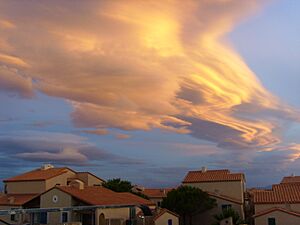Tramontane facts for kids
| The winds of the Mediterranean |
|---|
The Tramontane is a famous wind that blows from the north. Its name and exact direction can be a bit different depending on the country. The word "Tramontane" comes from the Italian word tramontana. This word means "beyond the mountains" in Latin. It first referred to the Alps mountains in Northern Italy.
Sometimes, "Tramontane" can also mean anything that comes from the other side of mountains. It can even describe something that feels foreign or strange.
Contents
The Tramontane Wind Around the World
Tramontane in Spain
In Spain, this wind is called tramuntana in Catalan. It is also known as tramontana in Spanish, Galician, and Basque. The wind gave its name to the Serra de Tramuntana mountain range in Mallorca.
This wind is common along the northern Mediterranean coast. This includes places like Catalonia, Mallorca, and Menorca. It can blow very strongly. In Catalan culture, especially in Empordà, there is a saying. If someone acts a bit strangely, they might be called "touched by tramuntana" (tocat per la tramuntana). The famous artist Salvador Dalí was often described this way in his home region.
Tramontane in Croatia
Along the Croatian Adriatic coast, the wind is called tramontana. People in Dalmatia pronounce it tramòntāna. There are also other local names for it.
The Tramontane is seen as a wind that brings change in the weather. It often turns into the bora wind. Like the bora, the Tramontane is strong. It can create big waves in the sea. However, it is not as gusty or sudden as the bora.
Tramontane in France

In France, the tramontane is a strong, dry, and cold wind. It blows from the north over the Mediterranean Sea. In areas like lower Languedoc, Roussillon, Catalonia, and the Balearic Islands, it comes from the northwest.
This wind is similar to the mistral wind. Both are caused by similar weather patterns. But they blow through different areas. The Tramontane speeds up as it passes between the Pyrenees mountains and the Massif Central plateau. The mistral, however, flows down the Rhone Valley.
The Tramontane forms when there is a big difference in air pressure. Cold air from a high pressure system over the Atlantic Ocean or northwest Europe meets a low pressure system over the Gulf of Lion in the Mediterranean. The high-pressure air moves south. It gains speed as it goes downhill. It is also squeezed between the Pyrenees and the Massif Central. This makes it blow even faster.
The name "tramontane" was used in France by the late 1200s. Marco Polo used it in 1298. It came from the Latin word transmontanus and the Italian tramontana. These words meant "across the mountains." But they also meant "the North Star." This is because the Alps mountains were north for the ancient Italic people.
In French, the phrase "perdre la tramontane" meant "to lose your way." By 1636, it also meant "to be confused." Some people say the constant sound of the Tramontane can be unsettling. The writer Victor Hugo wrote about this. In his poem "Gastibelza," a character says, "The wind coming over the mountain will drive me mad..."
Tramontane in Greece
In Greece, the word tramountána is used in sailing. It means the northern wind. But it also means the northern direction itself. It can even refer to the north point on a compass.
Tramontane in Italy
In Italy, the wind is called tramontana. It is a cold winter wind. It blows from the Alps and Apennines towards the Italian coast. It is very common on the west coast of Italy and northern Corsica.
This wind is caused by a weather system from the west. It follows a low-pressure area in the Ligurian Sea. This low pressure pulls in strong winds. The Tramontane is strongest before sunrise. It can reach speeds of 70 kilometers per hour (45 miles per hour). It is a fresh wind, similar to the mistral.
Sometimes, the sky is clear when the Tramontane blows. Other times, it can bring clouds and rain. This is called "dark Tramontane" (Tramontana Scura) in Liguria. This happens when storms from the west move over the Ligurian Sea. There is a saying in the Ligurian language: "tramuntann-a scüa, ægua següa" ("dark north wind, sure rain").
In Italy, the saying "to lose the Tramontane" (perdere la tramontana) was used by sailors. It meant losing your direction. Now, it is used more generally to mean losing your way or becoming confused.
Tramontane in Slovenia
In Slovenia, the word tramontana describes a very strong northern wind. It often blows with hurricane force. It comes from the Alps and blows over Trieste, the Slovenian coast, and Istria. Its gusts can sometimes reach 200 kilometers per hour. Usually, it blows at about 80 kilometers per hour.
This wind does not last very long, usually 2 to 4 hours in Koper bay. It often quickly changes into a bora wind. Because it is so strong, it can pull up trees. It also often damages boats by crashing them into the coast.
See also
 In Spanish: Tramontana para niños
In Spanish: Tramontana para niños
- Winds of Provence


